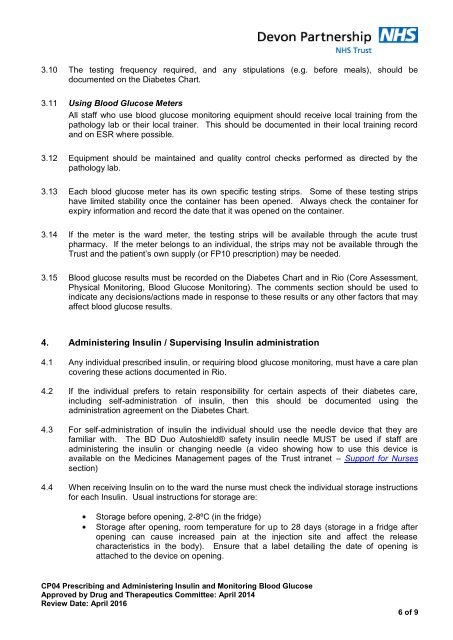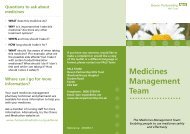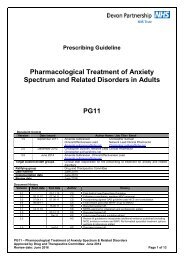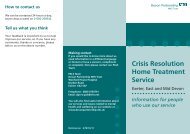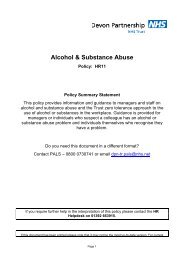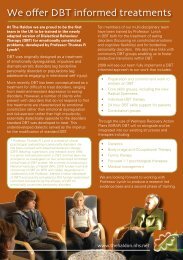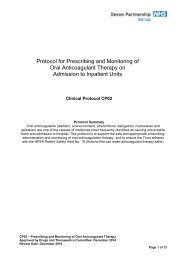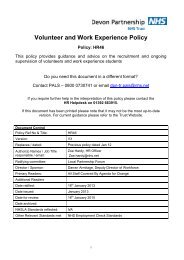CP04 Insulin and Blood Glucose - Devon Partnership NHS Trust
CP04 Insulin and Blood Glucose - Devon Partnership NHS Trust
CP04 Insulin and Blood Glucose - Devon Partnership NHS Trust
You also want an ePaper? Increase the reach of your titles
YUMPU automatically turns print PDFs into web optimized ePapers that Google loves.
3.10 The testing frequency required, <strong>and</strong> any stipulations (e.g. before meals), should be<br />
documented on the Diabetes Chart.<br />
3.11 Using <strong>Blood</strong> <strong>Glucose</strong> Meters<br />
All staff who use blood glucose monitoring equipment should receive local training from the<br />
pathology lab or their local trainer. This should be documented in their local training record<br />
<strong>and</strong> on ESR where possible.<br />
3.12 Equipment should be maintained <strong>and</strong> quality control checks performed as directed by the<br />
pathology lab.<br />
3.13 Each blood glucose meter has its own specific testing strips. Some of these testing strips<br />
have limited stability once the container has been opened. Always check the container for<br />
expiry information <strong>and</strong> record the date that it was opened on the container.<br />
3.14 If the meter is the ward meter, the testing strips will be available through the acute trust<br />
pharmacy. If the meter belongs to an individual, the strips may not be available through the<br />
<strong>Trust</strong> <strong>and</strong> the patient’s own supply (or FP10 prescription) may be needed.<br />
3.15 <strong>Blood</strong> glucose results must be recorded on the Diabetes Chart <strong>and</strong> in Rio (Core Assessment,<br />
Physical Monitoring, <strong>Blood</strong> <strong>Glucose</strong> Monitoring). The comments section should be used to<br />
indicate any decisions/actions made in response to these results or any other factors that may<br />
affect blood glucose results.<br />
4. Administering <strong>Insulin</strong> / Supervising <strong>Insulin</strong> administration<br />
4.1 Any individual prescribed insulin, or requiring blood glucose monitoring, must have a care plan<br />
covering these actions documented in Rio.<br />
4.2 If the individual prefers to retain responsibility for certain aspects of their diabetes care,<br />
including self-administration of insulin, then this should be documented using the<br />
administration agreement on the Diabetes Chart.<br />
4.3 For self-administration of insulin the individual should use the needle device that they are<br />
familiar with. The BD Duo Autoshield® safety insulin needle MUST be used if staff are<br />
administering the insulin or changing needle (a video showing how to use this device is<br />
available on the Medicines Management pages of the <strong>Trust</strong> intranet – Support for Nurses<br />
section)<br />
4.4 When receiving <strong>Insulin</strong> on to the ward the nurse must check the individual storage instructions<br />
for each <strong>Insulin</strong>. Usual instructions for storage are:<br />
Storage before opening, 2-8ºC (in the fridge)<br />
Storage after opening, room temperature for up to 28 days (storage in a fridge after<br />
opening can cause increased pain at the injection site <strong>and</strong> affect the release<br />
characteristics in the body). Ensure that a label detailing the date of opening is<br />
attached to the device on opening.<br />
<strong>CP04</strong> Prescribing <strong>and</strong> Administering <strong>Insulin</strong> <strong>and</strong> Monitoring <strong>Blood</strong> <strong>Glucose</strong><br />
Approved by Drug <strong>and</strong> Therapeutics Committee: April 2014<br />
Review Date: April 2016<br />
6 of 9


